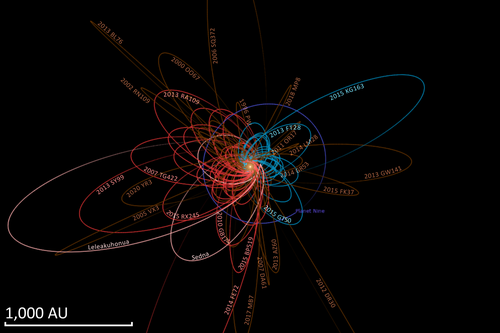| Discovery | |
|---|---|
| Discovered by | Cerro Tololo Obs. |
| Discovery site | Cerro Tololo Obs. |
| Discovery date | 29 July 2000 |
| Designations | |
| 2000 OO67 | |
| TNO [1] · centaur (DES ) [2] | |
| Orbital characteristics [1] | |
| Epoch 13 January 2016 (JD 2457400.5) | |
| Uncertainty parameter 2 | |
| Observation arc | 2187 days (5.99 yr) |
| Earliest precovery date | 29 July 2000 |
| Aphelion | 1,041.743 AU (155.8425 Tm) |
| Perihelion | 20.7305754 AU (3.10124994 Tm) |
| 531.2369251 AU (79.47191283 Tm) | |
| Eccentricity | 0.9609768 |
| 11760.29 yr (4295446.2 d) | |
Average orbital speed | 0.88 km/s |
| 0.328967° | |
| 0° 0m 0.302s / day | |
| Inclination | 20.0729° |
| 142.391° | |
| 212.345° | |
| Uranus MOID | 1.82 AU (0.272 Tm) [3] |
| TJupiter | 5.265 |
| Physical characteristics | |
| 64 km (est. at 0.09) [4] | |
| Temperature | ~12 K |
| 9.2 [1] | |
(87269) 2000 OO67 (provisional designation 2000 OO67) is a trans-Neptunian object, approximately 64 kilometers (40 miles) in diameter, on a highly eccentric orbit in the outermost region of the Solar System. It was discovered by astronomers at the Chilean Cerro Tololo Inter-American Observatory on 29 July 2000.
Contents

